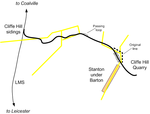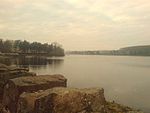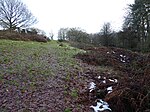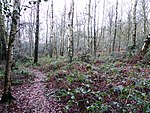Bardon Hill is the highest Hill in Leicestershire and on a clear day the Malvern and Shropshire Hills (approx. 50–60 miles), summits in Derbyshire (approx. 30–40 miles) and Lincoln Cathedral (almost 50 miles away) can be seen. However, the Sugar Loaf in South Wales, sometimes cited as visible from Bardon, cannot be seen, being over 90 miles (140 km) away.
Near the top of the hill are two radio masts; the smaller of the two was built for the BBC as a link for Outside broadcast linking into the Sutton Coldfield Transmitter. This was then moved to the now larger mast which was originally built by an electricity supply company, it is now owned by Cellnex after Arqiva sold its UK wireless business in October 2019 and provides the NOW Leicester DAB radio service.The landscape was already attracting visitors before John Curtis wrote in the 1830s: he suggests that the view extends to over 5,000 square miles (13,000 km2) or one-twelfth of England and Wales. Potter also notes of the view from Bardon Hill that "it probably commands a greater extent of surface than any other point of view on the island" and that "An outline, described from the extremity of this view, would include nearly one-fourth of England and Wales. It may be deemed one of the most extraordinary points of view in Nature." This has attracted telecommunication companies, and large transmitters and radio masts have replaced both the Summer House and Queen Adelaide's Bower.
Bardon Hill is also a 13.1-hectare (32-acre) biological Site of Special Scientific Interest (SSSI) in the civil parish of Bardon, east of Coalville in Leicestershire, England.Bardon Hill is part of the eroded remains of a volcano. It is the highest point in Leicestershire and the National Forest, 278 m (912 ft) above sea level. Due to its prominence, it is visible for many kilometres around. It adjoins Bardon Hill Quarry, a geological SSSI. At its summit are a trigonometrical point and a radio mast. The second highest hill in Leicestershire is the nearby Beacon Hill.
"Bardon" or "Bardon Hill" was also the name of a village south-west of the hill. Most of the village has been demolished but the toponym "Bardon Hill" remains in use as the postal address of the remaining local properties.










